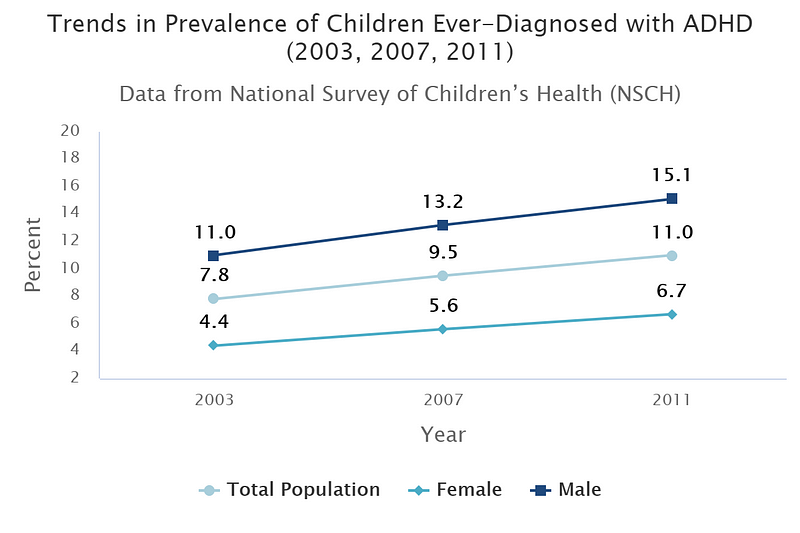My Misunderstood Mind
A look at how my adult ADHD diagnosis changed my life and how ADHD in girls and women is often overlooked.
Story by Shannon Steffens
I ’m a 9-year-old girl, daydreaming as my third grade teacher discusses multiplication tables. I’m 12 and struggle to follow conversations with friends; my mind can’t process their words while my thoughts are bouncing in every direction. I don’t understand how others can seem so “present.”
I’m 15, and I spend my lunch period in the library instead of my high school cafeteria, letting my stomach go empty because the buzzing chatter overwhelms me. A psychiatrist diagnoses me with social anxiety disorder because I avoid interactions and struggle to make friends.
This diagnosis is wrong, but I don’t know it yet.
I’m 17, 18, 19, 20, 21, and writing essays takes me hours upon hours, days upon days. I hear classmates say they wrote the entirety of theirs the night before with a laugh. I wonder how that’s possible — I struggle to focus on anything without opening a new tab and falling down an internet rabbit hole. I assume that it’s simply procrastination.

I make to-do lists every morning and I forget about them, just like I forget almost everything. I assume this absent-mindedness is due to a faulty hippocampus or a personality flaw.
I’m wrong, but I don’t know it yet.
I’m 22, and I’m diagnosed with inattentive-type Attention-Deficit/Hyperactivity Disorder (ADHD). So many aspects of my life suddenly make sense.
My experience isn’t unique. According to a 2020 study published by BMC Psychiatry, girls and women with ADHD are more likely to be diagnosed later in life and are more likely to be misdiagnosed with other disorders than boys and men.
This disorder presents differently by gender, which is the main reason girls struggling with ADHD are often overlooked. The study also found that girls are more likely to have internal symptoms (such as inattentiveness) than external symptoms (such as hyperactivity).
Ask yourself: when you think of ADHD, do you think of a boy bouncing off the walls of a classroom or a girl daydreaming at her desk? Both are correct, but many equate the disorder with hyperactivity rather than difficulty focusing.
In reality, there are three subtypes of ADHD: inattentive, hyperactive-impulsive and combined (both inattentive and hyperactive-impulsive). The hyperactive-impulsive and combined types are seen as easier to diagnose and are also more common in boys and men than in girls and women, according to Dr. Angela Heithaus, adult ADHD specialist.
Because of this, a higher percentage of boys are diagnosed than girls. In 2011, the National Survey of Children’s Health found 11% of boys had been diagnosed with ADHD compared to just 6.7% of girls.

Heithaus said she was inspired to study this disorder after being diagnosed herself. When her child was being evaluated for ADHD, she discovered that she had it also. She said being diagnosed after having children who are diagnosed is not an uncommon occurrence for women with ADHD.
“There’s a lot of misconceptions around [ADHD in women] and a lot of misinformation,” Heithaus said. “There’s really a need for people in the field who understand it.”
For a long time, ADHD was considered to only affect children. Heithaus said it was only a couple of decades ago that therapists and researchers began to understand that ADHD symptoms often continue into adulthood.
While untreated ADHD can cause a child to struggle in school, it can also be catastrophic to an adult’s life.
According to Lesley Todaro, licensed marriage and family therapist and co-founder of Hallowell Todaro ADHD Center, every aspect of a person’s life is affected by ADHD. Todaro often sees women who struggle to organize schedules, keep living spaces clean and maintain relationships and jobs.
“When [women] come in and get diagnosed, there is a lot of sadness around having waited so long without knowing,” Todaro said. “They think back on how hard they worked. Had they been diagnosed sooner, life would have been a lot easier.”
Typical treatment for ADHD involves a mix of medication and therapy, though going on medication can be a more difficult process for women than men. According to Children and Adults with Attention-Deficit/Hyperactivity Disorder, women are more likely to have anxiety and/or depression alongside their ADHD, so their treatment must consider coexisting disorders. Even more, ADHD symptoms can increase when estrogen levels fall, so hormone fluctuations can complicate medication further.
“[ADHD] can ruin somebody’s life, but if treated properly and understood properly, it’s a gift,” Todaro said.
In fact, according to Psychology Today, ADHD symptoms tend to improve creative and “out-of-the-box” thinking, which can benefit people’s lives in many ways.
It has now been three months since I was diagnosed. Since taking stimulant medication to help with my symptoms, I’ve noticed improvements in almost all aspects of my life. I can focus on my schoolwork, engage better when talking to friends and family and check every box on the to-do lists I make for myself every morning.
I’m no longer a distractible child or a confused, struggling teenager. I’m a 22-year-old woman who has ADHD.
My future’s bright, and I know that now.